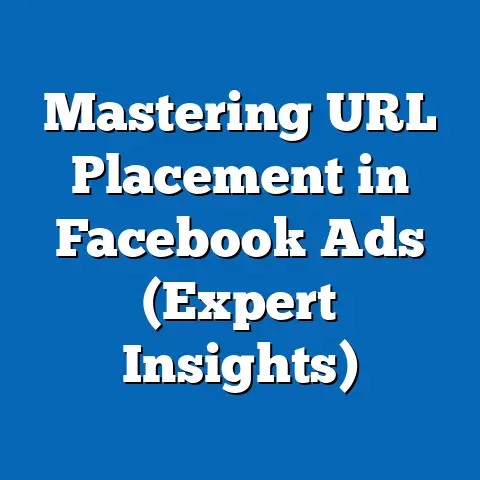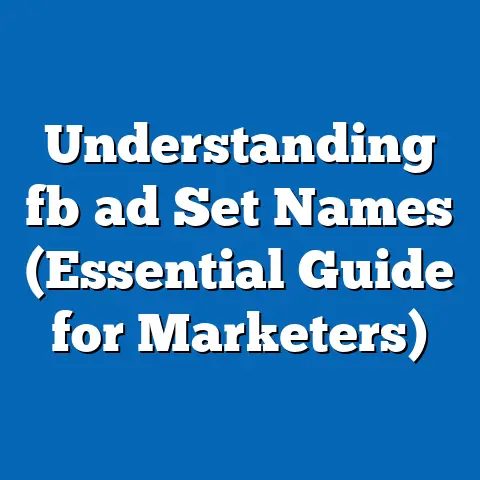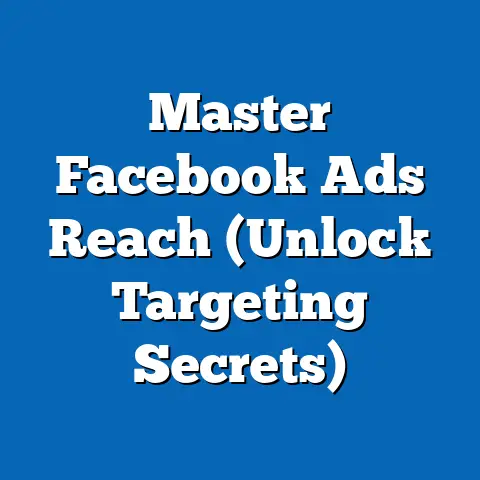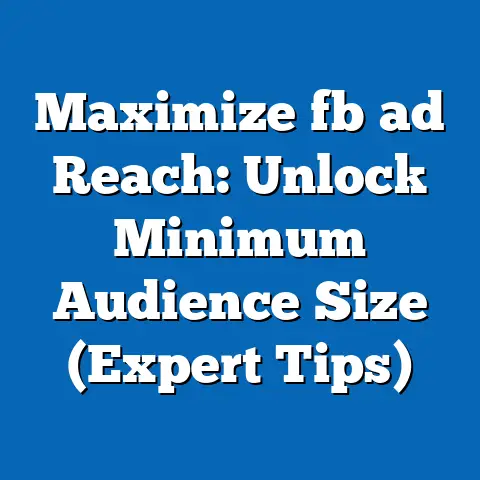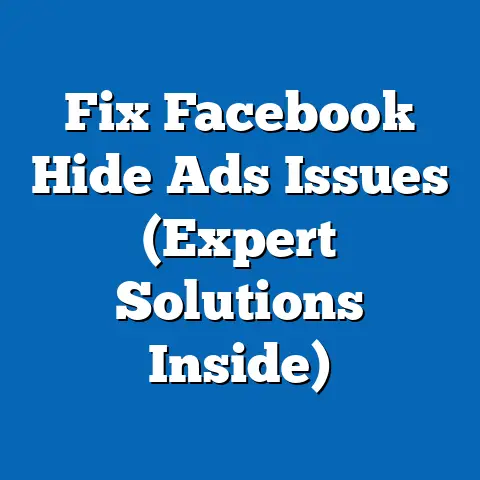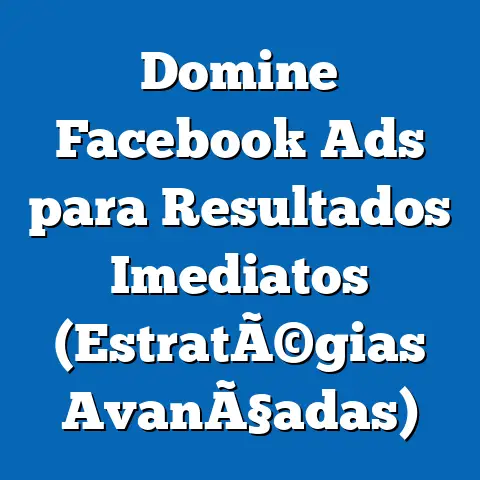Transform Attention in Facebook Ads (Proven Strategies)
Have you ever scrolled through Facebook, barely registering the ads that whiz by? I know I have. In fact, I’m guilty of instinctively scrolling past most ads, even when I know, intellectually, that some might be relevant to me. This is the reality we, as marketers, face every day. It’s a constant battle for fleeting attention in a world saturated with content. The average human attention span has shrunk dramatically in recent years – some studies suggest it’s now shorter than that of a goldfish! This isn’t just a quirky fact; it’s a critical challenge for anyone trying to make an impact with Facebook ads. Gone are the days when a simple product image and a catchy slogan were enough. Today, you need to transform attention – actively grabbing it, holding it, and converting it into meaningful engagement.
In this article, I’m going to share proven strategies that I’ve used and seen work to cut through the noise and make your Facebook ads truly captivating. We’ll dive deep into understanding attention, overcoming the challenges of the Facebook landscape, and implementing actionable tactics to transform your ad performance. Get ready to take notes, because this is about to get good!
Understanding Attention in Advertising
So, what does “attention” really mean in the context of Facebook advertising? It’s not just about someone seeing your ad. It’s about them actively noticing it, processing the information, and feeling compelled to take some kind of action, whether it’s clicking, liking, commenting, or even just remembering your brand later.
Think of it like this: you’re walking through a crowded marketplace. Vendors are shouting, music is playing, and countless sights and smells are vying for your attention. What makes you stop at one particular stall? Maybe it’s the vibrant colors, the enticing aroma, or the vendor’s engaging personality. The same principles apply to Facebook advertising.
The psychology of attention is fascinating. Our brains are constantly filtering information, prioritizing what’s relevant, interesting, or threatening. Several factors influence what captures our attention:
- Novelty: Something new or unexpected is more likely to grab our focus.
- Relevance: If the content is related to our interests, needs, or goals, we’re more likely to pay attention.
- Emotion: Content that evokes emotions, whether positive or negative, tends to be more memorable.
- Visual Appeal: Our brains process visual information much faster than text, making visuals a powerful tool for capturing attention.
In the crowded digital marketplace that is Facebook, capturing and holding attention is paramount. If your ad fails to stand out within the first few seconds, it’s likely to be lost in the endless scroll, resulting in wasted ad spend and missed opportunities.
The Challenges of Capturing Attention on Facebook
While Facebook offers incredible reach and targeting capabilities, it also presents some unique challenges when it comes to capturing attention.
- Algorithm Changes: The Facebook algorithm is constantly evolving, making it difficult for advertisers to consistently reach their target audience. Organic reach is at an all-time low, which means you’re relying more and more on paid advertising.
- Ad Fatigue: Users are bombarded with ads every day, leading to ad fatigue. They become desensitized to common advertising tactics, making it harder to grab their attention. I’ve seen campaigns that start strong, only to fizzle out after a few weeks as the audience becomes accustomed to the creative.
- Competition: Millions of businesses are vying for user attention on Facebook, creating a highly competitive environment. Your ads are competing not only with other ads but also with posts from friends, family, and other engaging content.
- Short Attention Spans: As mentioned earlier, attention spans are shrinking, forcing advertisers to make an impact within a matter of seconds. If your ad doesn’t grab attention immediately, it’s likely to be ignored.
I remember working with a local bakery that launched a Facebook ad campaign to promote their new line of vegan pastries. They used generic stock photos and bland copy that failed to highlight the unique selling points of their products. As a result, the campaign generated minimal engagement and ultimately flopped. This is a classic example of how failing to capture attention can lead to wasted ad spend and missed opportunities.
Proven Strategies to Transform Attention
Now that we understand the challenges, let’s dive into the strategies that can help you transform attention in your Facebook ads. These are the tactics I’ve seen consistently deliver results, and I’m excited to share them with you.
Eye-Catching Visuals
In the world of Facebook ads, visuals are king. They are the first thing users see and often the deciding factor in whether they stop scrolling or keep moving.
- High-Quality Images and Videos: This should be a no-brainer, but it’s worth emphasizing. Use high-resolution images and videos that are visually appealing and relevant to your brand. Avoid blurry, pixelated, or generic stock photos. I’ve found that investing in professional photography or videography can significantly improve ad performance.
- Color Psychology: Colors evoke different emotions and can influence user behavior. Use color psychology to your advantage by choosing colors that align with your brand and the message you’re trying to convey. For example, blue often conveys trust and reliability, while red evokes excitement and urgency.
- Composition: Pay attention to the composition of your visuals. Use the rule of thirds, leading lines, and other design principles to create visually balanced and engaging images and videos.
- Creativity: Don’t be afraid to experiment with creative visuals that stand out from the crowd. Use animation, GIFs, or interactive elements to capture attention.
- User-Generated Content (UGC): I’ve had incredible success using UGC in Facebook ads. Seeing real customers using and loving your product is incredibly powerful and authentic.
I once worked with an e-commerce brand that sold outdoor gear. They were struggling to generate engagement with their Facebook ads, which featured generic product photos. We decided to switch to UGC, featuring photos and videos of customers using their products in real-world settings. The results were astounding. Engagement skyrocketed, and the campaign generated a significant increase in sales.
Compelling Copywriting
While visuals are crucial, compelling copywriting is equally important for capturing and holding attention. Your copy should be concise, engaging, and relevant to your target audience.
- Attention-Grabbing Headlines: Your headline is the first thing users read, so make it count. Use strong verbs, create a sense of urgency, or ask a question to pique their interest.
- Concise and Clear Messaging: Get straight to the point and avoid jargon or complicated language. Use short sentences and paragraphs to make your copy easy to read and understand.
- Benefits, Not Features: Focus on the benefits of your product or service, rather than just listing its features. Explain how it will solve their problems or improve their lives.
- Strong Call-to-Action (CTA): Tell users exactly what you want them to do, whether it’s “Shop Now,” “Learn More,” or “Sign Up Today.” Use a clear and concise CTA that stands out visually.
- Storytelling: Don’t underestimate the power of storytelling. Share a relatable story that connects with your audience on an emotional level.
I worked with a non-profit organization that was struggling to raise donations through Facebook ads. Their initial ads featured dry statistics and generic appeals for help. We decided to revamp their copywriting and share personal stories of people who had benefited from their services. The response was overwhelming. Donations increased dramatically, and the campaign generated a significant amount of positive buzz.
Targeting and Personalization
Reaching the right audience with the right message is essential for capturing attention. Facebook’s targeting capabilities allow you to narrow down your audience based on demographics, interests, behaviors, and more.
- Detailed Targeting: Use Facebook’s detailed targeting options to reach users who are most likely to be interested in your product or service.
- Custom Audiences: Create custom audiences based on your existing customer data, website visitors, or email subscribers. This allows you to target users who are already familiar with your brand.
- Lookalike Audiences: Expand your reach by creating lookalike audiences based on your existing custom audiences. Facebook will identify users who share similar characteristics and behaviors.
- Personalized Ads: Use dynamic ad creative to personalize your ads based on user data. For example, you can show users ads for products they’ve previously viewed on your website or target them with personalized offers based on their location.
I helped a local restaurant increase its lunch business by targeting Facebook ads to people who worked within a 5-mile radius. The ads featured mouth-watering photos of their lunch specials and offered a 10% discount for first-time customers. The campaign was a huge success, driving a significant increase in foot traffic during lunchtime.
Engaging Formats and A/B Testing
Facebook offers a variety of ad formats, each with its own strengths and weaknesses. Experiment with different formats and conduct A/B testing to discover what resonates best with your audience.
- Image Ads: Simple and effective for showcasing your product or service.
- Video Ads: Highly engaging and perfect for telling stories or demonstrating your product in action.
- Carousel Ads: Allow you to showcase multiple products or services in a single ad.
- Collection Ads: Create a visually immersive experience that allows users to browse your products directly within the ad.
- Instant Experience Ads: Offer a full-screen, interactive experience that can be used to showcase your brand or product in a more engaging way.
- A/B Testing: Test different ad formats, visuals, headlines, and CTAs to see what performs best. Use Facebook’s built-in A/B testing tools to track your results and make data-driven decisions.
I once worked with a clothing retailer that was struggling to generate sales with their Facebook ads. They were primarily using image ads, but we decided to experiment with carousel ads. We created a carousel ad that showcased different outfits from their new collection, each with a direct link to the product page. The carousel ad significantly outperformed the image ads, driving a substantial increase in sales.
Measuring Attention and Success
Capturing attention is only half the battle. You also need to measure the success of your Facebook ads in terms of attention and engagement. Here are some key metrics to focus on:
- Engagement Rate: Measures the percentage of users who interacted with your ad (likes, comments, shares).
- Click-Through Rate (CTR): Measures the percentage of users who clicked on your ad.
- Conversion Rate: Measures the percentage of users who completed a desired action (e.g., purchase, sign-up).
- Video Completion Rate: Measures the percentage of users who watched your video ad to completion.
- Relevance Score: A metric that measures how relevant your ad is to your target audience.
Use Facebook Ads Manager to track your ad performance and identify areas for improvement. Analyze your data regularly and make data-driven decisions to optimize your campaigns. I often use custom reporting to dig deeper into the data and identify trends that might be missed with standard reports.
Conclusion
Transforming attention in Facebook ads is essential for success in today’s crowded digital landscape. By understanding the psychology of attention, overcoming the challenges of the Facebook platform, and implementing the proven strategies I’ve shared, you can create ads that truly captivate your target audience.
Remember to focus on eye-catching visuals, compelling copywriting, targeted personalization, and engaging ad formats. Don’t be afraid to experiment and conduct A/B testing to discover what resonates best with your audience. And always track your results and make data-driven decisions to optimize your campaigns.
Now, I challenge you to take these insights and apply them to your next Facebook ad campaign. Experiment with new visuals, craft compelling copy, and target your audience with laser precision. The results might surprise you. Good luck, and happy advertising!

